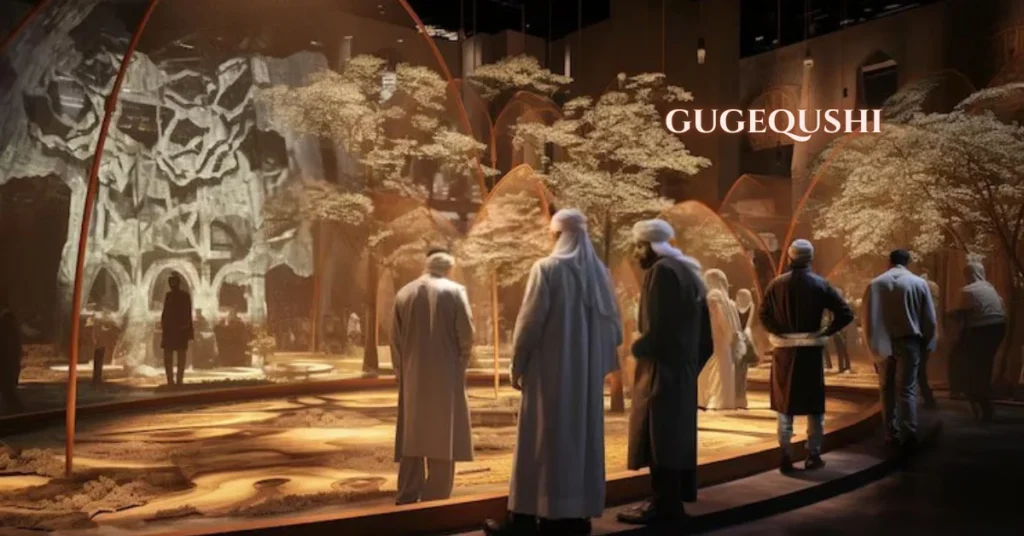Introduction
In a world where stories traverse time, cultures, and digital realms, gugequshi stands as a vibrant testament to the enduring power of narrative art. Have you ever wondered how ancient oral traditions can morph into modern digital marvels? That’s precisely what makes gugequshi an enthralling subject today. This form of storytelling is steeped in rich heritage while dynamically evolving to meet the demands of a global, connected audience. In this article, we’re going on a journey—from its humble beginnings in tradition to its brilliant reimagining in the digital age. So, buckle up as we explore the captivating world of gugequshi.
Background of Gugequshi
The term gugequshi resonates with those who cherish cultural heritage and storytelling. Historically, it refers to a unique narrative art form that has been passed down from generation to generation. While its origins lie in intimate gatherings where elders shared captivating tales, modern innovations have propelled it into the digital realm, ensuring that this ancient craft remains relevant and accessible to everyone.
As you read on, you’ll discover how gugequshi bridges the gap between the old and the new, offering more than just stories—it provides a dynamic connection to history and collective memory.
The Digital Revolution in Storytelling
Digital technology has revolutionized how we communicate, and storytelling is no exception. The incorporation of modern media platforms has allowed gugequshi to be shared with a global audience in ways unimaginable just a few decades ago. What used to be confined to the spoken word is now enhanced with multimedia elements—videos, podcasts, interactive web features, and social media posts, all combining to create a richer narrative tapestry.
By embracing these digital tools, storytellers have transformed gugequshi into a live, interactive experience. Do you remember the thrill of hearing a story directly from its source? The same excitement now pulsates through screens and speakers worldwide, making every listener a part of the evolving narrative.
Historical Roots of Gugequshi
Origins in Oral Traditions
The roots of gugequshi stretch back to an era when words and emotions conveyed stories around campfires and community gatherings. Oral storytelling was not just entertainment; it was a vital means of preserving history, culture, and shared values. These narratives provided lessons, moral guidance, and a sense of identity to communities, binding individuals through common experiences.
Imagine a time when every tale was told with passion and expressive gestures, where each storyteller added unique intonations and pauses that heightened the dramatic effect. That is the soul of gugequshi—an art form that emerged from the simplicity and intimacy of human connection.
Transition to Written Narratives
As time went on, the need to preserve these ephemeral moments led to the transition from oral to written traditions. Scribes and storytellers began documenting these rich narratives, thereby cementing the legacy of gugequshi for future generations. Although written records provided permanence, they also marked a shift in how stories were consumed—from a shared, communal experience to one that could be revisited in solitary reflection.
This evolution played a significant role in broadening the reach of gugequshi, making it accessible to a wider audience beyond its initial, localized circles. Yet, even with the written word, the warmth and energy of the original oral tradition never fully faded—it just found new ways to shine.
Cultural Significance of Gugequshi
Role in Preserving Heritage
At its core, gugequshi is a custodian of culture. It carries within it the essence of the past, encapsulating traditions, moral lessons, and the identity of its people. Every narrative is infused with the collective memory of a community, making it a living archive of cultural heritage. Through gugequshi, younger generations not only learn about their history but also experience the emotions and values of their ancestors.
By preserving these stories, gugequshi acts as a bridge between past and present, ensuring that the wisdom of bygone eras is not lost. It nurtures a sense of belonging and pride among those who listen, celebrate, and eventually pass on these treasured tales.
Impact on Community and Identity
Stories have a unique power: they shape our perceptions of who we are and where we come from. Gugequshi plays a critical role in shaping community identity. By repeatedly engaging with these narratives, listeners and readers develop a deeper connection with their cultural roots. It’s a form of storytelling that goes beyond mere words—it weaves together the very fabric of communal identity.
In modern society, where globalization and digital media often blur cultural boundaries, gugequshi remains a steadfast reminder of the individuality and richness of local traditions. This duality of maintaining tradition while adapting to new times is what makes gugequshi so profoundly impactful.
The Digital Transformation
Embracing Multimedia Platforms
So, how has gugequshi transformed in today’s digital landscape? The answer lies in its seamless integration with multimedia platforms. The shift from solely oral and written forms to digital content has opened up exciting avenues for storytelling. For instance, animated series and video documentaries bring gugequshi to life, combining visuals with narration to captivate modern audiences.
Digital platforms allow creators to add layers of context—soundtracks, visual effects, and interactive elements enrich the experience, making it more engaging than ever before. This multimedia approach not only honors the traditional roots of gugequshi but also reinvents it for a generation raised on digital innovation.
The Rise of Interactive Storytelling
Beyond visuals, the digital age has ushered in interactive storytelling, where audiences become active participants. Web-based platforms, mobile apps, and social media campaigns now enable users to engage directly with gugequshi. Imagine being able to choose the path of a story, comment in real time, or even contribute your own twists to a traditional tale. This level of interactivity not only enhances the narrative experience but also fosters a community of storytellers and listeners working together to evolve the tradition.
Interactive storytelling transforms passive consumption into an active, immersive experience—one that makes you feel like a part of the unfolding tale. This dynamic engagement is redefining how we experience narratives and is a key driver behind the renewed popularity of gugequshi.
Technology’s Impact on Gugequshi
Social Media and Global Outreach
Social media platforms have been instrumental in spreading gugequshi far beyond its traditional origins. Platforms like Facebook, Twitter, Instagram, and TikTok allow storytellers to share snippets of their narratives with a global audience. With just a click, a powerful story can travel across continents, engaging viewers from diverse cultural backgrounds.
This global outreach has not only amplified the reach of gugequshi but also brought together a mosaic of voices, each adding their unique perspective to the traditional art form. It’s like creating a digital quilt where every patch represents a different culture, yet together, they tell one unified story.
Digital Challenges and Opportunities
However, the digital era is a double-edged sword. With an overwhelming amount of content available online, distinguishing genuine, high-quality gugequshi can be challenging. Content saturation means that storytellers must innovate constantly to capture and retain their audience’s attention.
Moreover, preserving the authenticity of gugequshi in a commercialized digital space is a significant hurdle. Yet, these challenges also present unique opportunities—storytellers have the chance to experiment, collaborate, and push the boundaries of traditional storytelling like never before.
Modern Adaptations of Gugequshi
Podcasts, Videos, and Beyond
One of the most exciting modern adaptations of gugequshi is its transformation into podcasts and video series. Podcasts, in particular, have emerged as a popular medium for narrative art. The intimate, conversational tone of an audio format mirrors the age-old tradition of oral storytelling, creating a sense of closeness between the narrator and the listener.
Video adaptations add another dimension by incorporating visual storytelling. Animated renditions of traditional tales, documentary-style narratives, and even live-action recreations make gugequshi accessible to a tech-savvy audience. These formats allow the art form to be experienced in versatile ways, appealing to various preferences and learning styles.
Collaborative and Crowdsourced Narratives
Innovation in the digital space has also paved the way for collaboration. Today, gugequshi is not just the domain of a single storyteller; it’s evolving into a collaborative art form where communities contribute, share, and build upon each other’s ideas. Crowdsourced narratives, where listeners provide input or vote on story directions, exemplify the dynamic nature of modern storytelling.
Such collaborative efforts ensure that gugequshi remains relevant and adaptive. They break down the barriers between creator and audience, making storytelling a communal, interactive endeavor that evolves continuously.
Global Expansion of Gugequshi
Breaking Geographical Barriers
Digital connectivity has dissolved the geographical boundaries that once confined gugequshi to local communities. Today, a story born in one corner of the globe can travel and resonate with people thousands of miles away. This cross-pollination of ideas enriches the narrative, offering a fusion of diverse cultural elements while staying true to its roots.
Global expansion means that gugequshi is no longer just a regional tradition—it’s becoming a universal language of storytelling. New storytellers from different parts of the world bring their unique flavors, creating a richer and more diverse tapestry of narratives that appeal to a global audience.
Cross-Cultural Exchanges
As gugequshi reaches a broader audience, it catalyzes cross-cultural dialogue. Cultural festivals, online forums, and virtual storytelling events provide platforms for enthusiasts to share their interpretations and adaptations. These exchanges not only promote cultural understanding but also inspire innovation within the art form.
Each shared story becomes a bridge, connecting communities and nurturing a global appreciation for the timeless art of storytelling. It’s a fusion of traditions, where every tale, though unique, contributes to a larger narrative of human experience.
Future Prospects of Gugequshi
Innovation with Tradition
So, what does the future hold for gugequshi? The answer lies in the harmonious blend of innovation and tradition. As technology continues to evolve, so too will the methods of storytelling. However, the essence of gugequshi—its ability to connect hearts and preserve heritage—will remain unchanged.
Future prospects include augmented reality (AR) and virtual reality (VR) experiences that could immerse audiences even further into the narrative. These advancements promise to recreate the magical ambiance of traditional storytelling in futuristic, interactive ways.
Sustainable Digital Storytelling
The challenge ahead is to maintain the authenticity and cultural integrity of gugequshi while embracing innovative digital formats. Sustainable digital storytelling involves developing models that support creators, ensure fair use of narratives, and prioritize cultural preservation over mere commercial gain. By fostering communities that value genuine storytelling, the future of gugequshi looks promising and resilient.
Conclusion
In the grand tapestry of narrative art, gugequshi stands as a bridge between eras—a vibrant storyteller that continues to evolve without losing its soul. From its ancient roots in oral traditions to its dynamic reimagining in the digital age, gugequshi offers a unique glimpse into our shared cultural heritage. It reminds us that while technology changes the way we tell stories, the heart of every narrative—the human connection—remains eternal. Whether you’re a die-hard fan of traditional storytelling or a digital native exploring new media, the journey with gugequshi is one of wonder, innovation, and lasting cultural significance.
FAQs
What is gugequshi?
Gugequshi is a unique storytelling art form that originated from oral traditions, evolving through written narratives, and now thrives on digital platforms.
How has gugequshi transitioned to the digital age?
Modern technology has enabled gugequshi to incorporate multimedia elements, interactive features, and global outreach through social media, podcasts, and videos.
What role does technology play in modern gugequshi?
Technology enhances the reach and impact of gugequshi by providing innovative ways to share and interact with stories, while also creating challenges in maintaining authenticity.
Can gugequshi still preserve cultural traditions?
Absolutely. Even as it adapts to digital formats, gugequshi continues to serve as a custodian of cultural heritage, preserving values and traditions through every narrative.
What does the future look like for gugequshi?
The future of gugequshi is bright, blending advanced technologies like VR and AR with time-honored traditions to create immersive, sustainable storytelling experiences.






